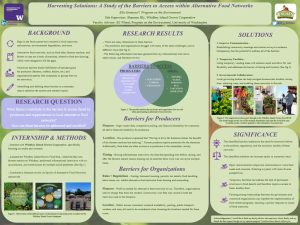HARVESTING SOLUTIONS: A STUDY OF BARRIERS TO ACCESS WITHIN ALTERNATIVE FOOD NETWORKS
Alternative Food Networks (AFNs) are an extremely valuable addition to local food systems. AFNs such as farmers markets and food hubs provide people with access to sustainable and fresh produce, stimulate the local economy, and are a major source of income for the producers. Despite the extensive benefits, the full potential of AFNs support for communities has not been realized. Significant barriers prevent both farmers, organizations, and customers from accessing the full range of advantages AFNs can provide. The purpose of this study is to identify and conceptualize the barriers to access within AFNs for both producers and organizational parties. To do this, I conducted interviews, reviewed literature, and gathered observation evidence with the following questions in mind: What factors contribute to the barriers to access in local food networks, specifically food hubs and farmers markets? How can these barriers be addressed and rectified? Ultimately, I discovered that there are many different dimensions of barriers such as regulations, timing, location and pricing. Governmental regulations, like zoning requirements, are hindering the development of AFNs and timing/locational aspects are keeping farmers away from valuable farm work. Additionally, the host organization, producer, and customer struggle with pricing disagreements. These aspects keep communities from experiencing the full benefits of these networks. To change this, each category of barrier needs to be addressed. Only then will AFNs reach their full potential and fill current gaps (food insecurity, high costs, excessive waste, ect.) in our food systems, like they were intended to do.
